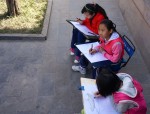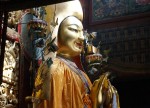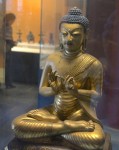Lama Temple is the largest and best-preserved lamasery in Beijing. The “Yonghe Temple” is located in Beijing’s Dongcheng District, near the northeastern corner of the Second Ring Road. Lines 2 and 5 of the Beijing Subway both stop at Yonghegong Lama Temple Station.
It was built in 1694 during the Qing Dynasty (1644-1911) as the residence of the Emperor Yongzheng. It originally served as an official residence for court eunuchs. It was then converted into the court of the Prince Yong (Yin Zhen), a son of the Kangxi Emperor and himself the future Yongzheng Emperor. After Yongzheng’s ascension to the throne in 1722, half of the building was converted into a lamasery, a monastery for monks of Tibetan Buddhism. The other half remained an imperial palace.
The temple is said to have survived the Cultural Revolution due to the intervention of Premier Zhou Enlai. It was reopened to the public in 1981.
The resplendent architectural complex is endowed with the style of an imperial palace, making it distinctive from others. It occupies an area of 66,400 sqm and can be described as a mini-palace with yellow glazed tiles on the roof and red walls circling the group of buildings.
Every element of the temple is entirely symmetrical, with main halls on a north-south axis and wing halls on both sides.
The Temple is arranged along a north-south central axis, which has a length of 480m. The main gate is at the southern end of this axis. Along the axis, there are five main halls which are separated by courtyards: the Hall of the Heavenly Kings (Tian Wang Dian or Devaraja Hall), the Hall of Harmony and Peace (Yonghegong), the Hall of Everlasting Protection (Yongyoudian), the Hall of the Wheel of the Law (Falundian), and the Pavilion of Ten Thousand Happinesses (Wanfuge).
The temple combines various architectural styles of the Han, the Manchu, the Mongolian and the Tibetan.
The Pavilion of Ten Thousand Happinesses the last main hall, is the highest hall of this temple. It is a three-storey building and contains an 26 m tall (18 m above the ground and 8 m underneath) statue of the Maitreya Buddha carved from a single piece of White Sandalwood. The seventh Dalai presented it to the Emperor Qianlong, the son of Emperor Yongzheng. The statue is one of three artworks in the Temple which were included in the Guinness Book of Records in 1993.
Pics taken in Spring 2014.
The temple is intensively used by Chinese people to pray and ask for favors. Incense is now strictly controlled to reduce pollution and one gets a standard package when going inside. Normally one uses three incense sticks each time at each altar, sometimes the tips are first put into a fire, sometimes just used like that. After kneeling and then bowing three times, the sticks are left in a container. Mostly people have to stand in line for their turn to kneel down.
The admission ticket also comes with a mini disk with a VCD introducing the temple.
More details:
http://www.beijingtrip.com/attractions/lamatemple.htm
http://en.wikipedia.org/wiki/Yonghe_Temple


































